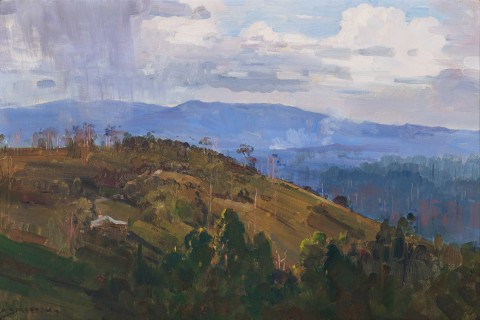OLINDA HILLSIDE
ARTHUR STREETON
oil on canvas
51.5 x 77.0 cm
signed lower left: A STREETON
Private collection
Christie's, Melbourne, 13 March 1975, lot 350 (as 'Dandenong Ranges')
Private collection, Melbourne
With their remarkable evocation of light, atmosphere, colour and form, Arthur Streeton’s landscapes remain among the most highly regarded and much-loved paintings in Australian art. From his sun-drenched impressionist scenes of the 1880s, to his joyful depictions of Sydney’s beaches and harbour in the 1890s and grand pastorals of the 1920s and 30s, he has bequeathed a rich legacy of images that celebrate Australia’s unique natural environment and continue to define our national consciousness. Among his later landscape achievements arguably most poignant are those inspired by Streeton’s time at Olinda in the Dandenong ranges – encapsulated magnificently in this auction by lot 19 and the present, Olinda Hillside. Not only do such works remain unparalleled in their concerted quality, but they are significant for their sensitivity to place and to the conservation concerns of the artist who was staunchly opposed to the increasing devastation of the area’s native forests and trees.
After twenty-three years abroad as an expatriate in London, Streeton returned to Australia permanently in September 1923 and, following the sale of his iconic Golden Summer, Eaglemont, 1889 (National Gallery of Australia) for the extraordinary sum of 1000 guineas in 1924, was able to build a house on land he had purchased in 1921 at Olinda in the Dandenong Ranges. Initially a weekend retreat and place of contemplation before becoming his permanent home in 1939 after the death of his wife Nora, the house he built there – ‘Longacres’ – and the surrounding hills and panoramic vistas offered the perfect setting for Streeton to consolidate his appreciation of momentary sensations of colour and light and to explore new ways of representing the Australian landscape. As he wrote to his dear friend and fellow artist, Tom Roberts, ‘It’s refreshing to note how the old Dandenong Range takes hold directly as soon as you get there…’1 Living in this landscape, nurturing the indigenous trees on his property, and blending them into a garden of introduced plants and flowers led to an intimate knowledge of the environment2 – and in turn, some of his most enduring and memorable works.
Capturing the ephemeral beauty of the area, Olinda Hillside exudes a tangible sense of the arcadian pleasure Streeton found in his self-made paradise through the charm of everyday domestic detail, the verve of the brushwork, and the easy harmony of the composition. Bathed in a gentle light that is uniquely Australian, indeed the work does not bear the character of a political statement in the vein of other Olinda paintings such as Last of the Messmates, 1928 (private collection); The Vanishing Forest, 1934 (Art Gallery of Ballarat, on loan from the Estate of Margery Pierce), or particularly, the starkly confronting Sylvan Dam and Donna Buang AD 2000, 1940 (private collection) where Streeton not only documents the damage being wreaked on the natural world, but condemns with growing vehemence the political and commercial motivations underlying it. A passionate environmentalist in his later years, Streeton notably questioned why ‘should we suffer hundreds and hundreds of acres of valuable timber to be destroyed to facilitate some work of the moment when so little is gained for it?’3 Moreover, cultural historian Tim Bonyhady, has observed that from 1930 onwards ‘…one of Streeton’s refrains became that his ideal of an afterlife was not the ‘ghastly monotony’ of either heaven or hell but to come back to Olinda, haunt his blackwoods and ‘scare the life’ out of anyone who cut down any of the trees he had planted.’4
1. Streeton letter, 7 May 1923, cited in Galbally, A. (ed.), Letters from Smike: The Letters of Arthur Streeton, 1890 – 1943, Oxford University Press, Melbourne, 1989, p.170
2. Tunnicliffe, W., ‘The Big Picture: National Landscapes’ in Streeton, Art Gallery of New South Wales, Sydney, 2020, p. 260
3. Argus, Melbourne, 27 November 1925, p. 23, quoted in Eagle, M., The Oil Paintings of Arthur Streeton in the National Gallery of Australia, National Gallery of Australia, Canberra, 1994, p. 164
4. Bonyhady, T., ‘Beware of the Axe’ in Streeton, op. cit, p. 313
VERONICA ANGELATOS
